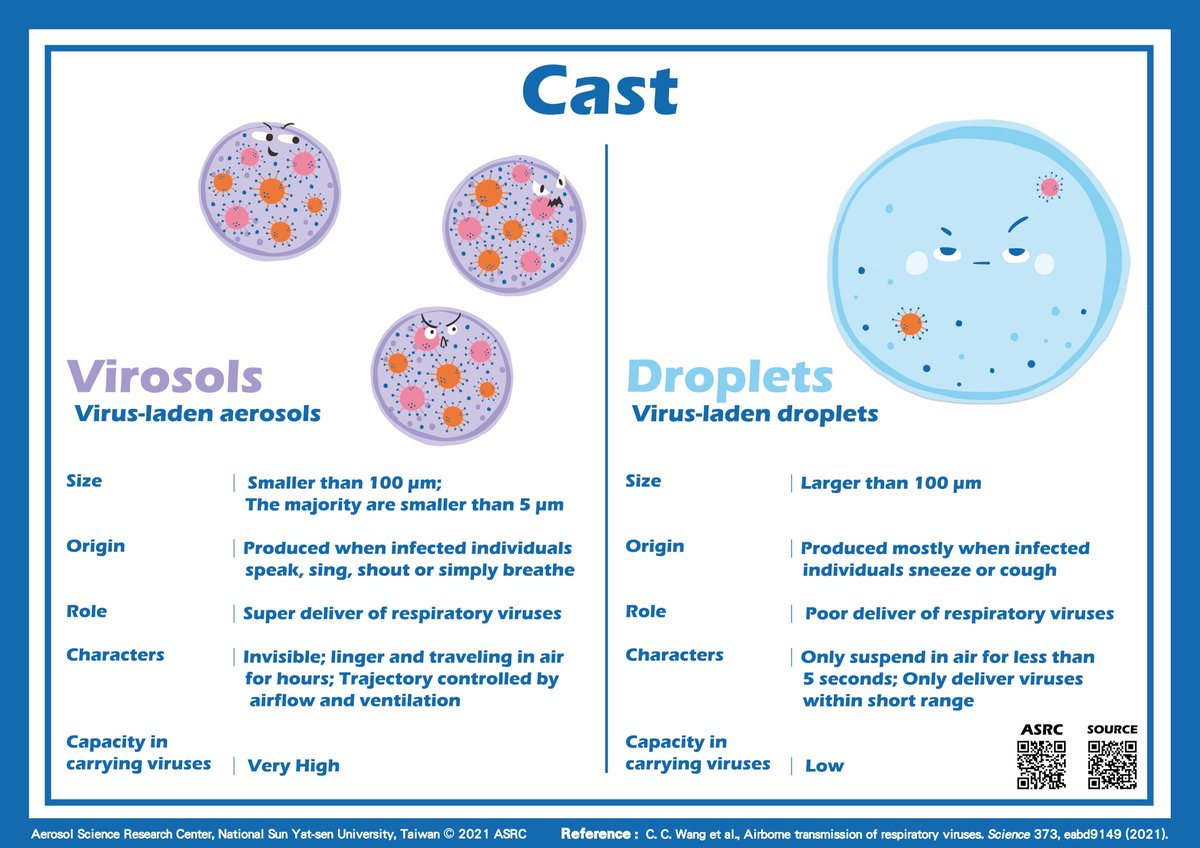
1/ HOW COVID TRANSMISSION WORKS: the short version
I believe it is extremely important to communicate clearly how transmission really happens.
Then, one can understand easily real ways to limit transmission. And it reduces resistance to e.g. masks.
I believe it is extremely important to communicate clearly how transmission really happens.
Then, one can understand easily real ways to limit transmission. And it reduces resistance to e.g. masks.
2/ SOME, NOT ALL infected people (those with high viral load during a certain period of the illness) exhale aerosols that float in the air. Many more if they talk / yell / sing / exercise.
More details in this paper in @ScienceMagazine:
More details in this paper in @ScienceMagazine:
https://twitter.com/jljcolorado/status/1430967286244970502
4/ It is very easy to get infected in close proximity, because we inhale a lot of the air that leaves the other person with little dilution
journalofhospitalinfection.com/article/S0195-…
journalofhospitalinfection.com/article/S0195-…

5/ The dominance of short-range airborne infection in close proximity has been confused for 110 years with "sprayborne droplet transmission", since Charles Chapin made that error in his 1910 book, that became the #DropletDogma until now
papers.ssrn.com/sol3/papers.cf…
papers.ssrn.com/sol3/papers.cf…

6/ The error confusing short-range airborne infection in close proximity with sprayborne droplet infection was foundational in the @CDCgov, and from there it has permeated the infection control book everywhere, as we discuss in our preprint:
papers.ssrn.com/sol3/papers.cf…
papers.ssrn.com/sol3/papers.cf…

7/ One can get infected, not only in close proximity, but also when sharing room air, bc "exhaled smoke" accumulates in room
E.g. the Skagit choir we investigated, & 1000s of others. All superspreading investigated points to airborne, none to droplets
E.g. the Skagit choir we investigated, & 1000s of others. All superspreading investigated points to airborne, none to droplets
https://twitter.com/jljcolorado/status/1306450428867964930
8/ @WHO and others tell us that airborne transmission is only an issue "when there is poor ventilation"
But if exhaled infectious aerosols can infect when they accumulate in a room, they MUST be much more infectious in close proximity. (What has traditionally called "droplets")
But if exhaled infectious aerosols can infect when they accumulate in a room, they MUST be much more infectious in close proximity. (What has traditionally called "droplets")

9/ CRITICALLY, ventilation is "not good" IN MOST INDOOR SPACES WORLDWIDE, including in advanced countries like US. Shouldn't be made to sound like an exception, but we should assume that ventilation is not good unless demonstrated otherwise (CO2 meters)
science.org/doi/10.1126/sc…
science.org/doi/10.1126/sc…
10/ If you want more details on how we know airborne transmission is dominant for COVID-19, see this @TheLancet paper, explained in this thread:
https://twitter.com/jljcolorado/status/1383566908797059078
11/ If you want more details on how all (or almost all) respiratory diseases are actually airborne, see this @ScienceMagazine paper, explained in this thread:
(Not that surprising if you think about it! They are respiratory diseases after all)
(Not that surprising if you think about it! They are respiratory diseases after all)
https://twitter.com/jljcolorado/status/1430967286244970502
12/ If you want more details on how to protect yourself from airborne transmission, see Tweets #40-80 and later on the thread explaining the @ScienceMagazine paper:
https://twitter.com/jljcolorado/status/1430986845031174146
13/ If you want to understand the history of how the #DropletDogma became SOOO entrenched, so that @WHO and @CDCgov were unable to understand transmission, see this thread on the history:
https://twitter.com/jljcolorado/status/1391111720526024708
14/ For more details on the history, see the Randall et al. paper that we recently published in J. Royal Society Interface:
https://twitter.com/jljcolorado/status/1448309187784577028
15/ For even more details on the history (an article that explains similar material to the thread linked in tweet #13 here), see his preprint (under peer-review right now):
papers.ssrn.com/sol3/papers.cf…
papers.ssrn.com/sol3/papers.cf…
16/ Although perhaps best way to understand history is to read this article in @wired by @meganmolteni
Explains the research led by @katierandall and @linseymarr (with yours truly supporting as I could) to find the origins of the errors in #DropletDogma
wired.com/story/the-teen…
Explains the research led by @katierandall and @linseymarr (with yours truly supporting as I could) to find the origins of the errors in #DropletDogma
wired.com/story/the-teen…
17/ If you want more details about the implications of this paradigm shift in the understanding of respiratory disease transmission for indoor air quality and ventilation, see this @ScienceMagazine paper, explained in this thread:
https://twitter.com/jljcolorado/status/1392947638153093121
18/ For a comic version explaining respiratory disease transmission and how to protect ourselves, see this thread, which explains the comics that @ChiaWang8 (lead author of @ScienceMagazine paper) made:
https://twitter.com/jljcolorado/status/1435977594302713858
19/ For a summary of the huge error made by @WHO declaring "FACT: IT IS NOT AIRBORNE" and calling airborne "misinformation"(one of the worst errors in the history of public health) see this thread on the 1-year anniversary:
https://twitter.com/jljcolorado/status/1376290976172490754
20/ Only hope that my colleagues and I can stop having to shout from the Twitter rooftops, because finally @WHO and @CDCgov etc. will say this themselves. Science is extremely clear.
But there are residual confusion w/ #DropletDogma, political obstacles
But there are residual confusion w/ #DropletDogma, political obstacles
https://twitter.com/mdc_martinus/status/1444420356698214408
21/ La mayoría de los hilos están también en español, ver:
https://twitter.com/jljcolorado/status/1382838079191355394
https://twitter.com/jljcolorado/status/1431755596387209222
https://twitter.com/jljcolorado/status/1432134527388901377
https://twitter.com/jljcolorado/status/1441171795147591681
https://twitter.com/jljcolorado/status/1376184194091651075
https://twitter.com/jljcolorado/status/1375064813907361792
https://twitter.com/jljcolorado/status/1356045414525497354
https://twitter.com/jljcolorado/status/1366075842569400320
• • •
Missing some Tweet in this thread? You can try to
force a refresh











